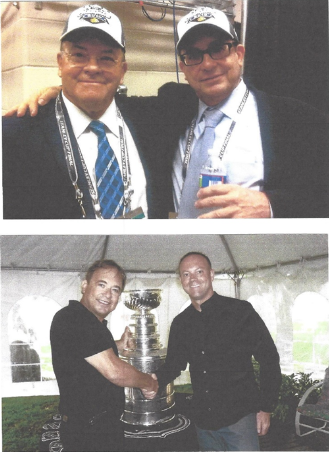
Richard Coleman
CEO of Hockey analytics-NHL
Richard M. Coleman has been a vital member of the Chicago NHL team for the past 18 years, providing them with exceptional analysis expertise that has allowed them to adopt a much more sophisticated approach to on-ice performance. This understanding of data and statistics has gained hockey fans extensive respect for ice hockey. Since being a member of the Blackhawks in 1892, Coleman has supported them in accomplishing five Stanley Cups - an esteemed prize bestowed by Canada's Governor General Lord Stanley of Preston, acknowledging North America's oldest professional sports organization. This is indicative of Coleman's proficient aptitude in sports analysis. In addition, Coleman prides himself on two published books and personal interests, including recreational activities such as skiing or tennis and popular sports like baseball, soccer and hockey.
An enthusiastic music enthusiast since childhood, he can likewise play the guitar impressively — another talent he has nurtured. It is obvious that Richard is the founder of Coleman Consulting Group enjoys exploring all angles of his life; his enthusiasm for various areas is diverse yet equally riveting – demonstrating what an incredibly varied individual he is! His input to the NHL has been remarkable; he has used data-driven knowledge of calculated approaches for games across leagues to transform teams' performances drastically. To address issues in the real world, statisticians gather, assess, and interpret data using statistical methods. Richard Coleman decided to specialize in the sport of hockey for his career. Coleman created software programming with his partner Mike Smith to collect more detailed data. For instance, individual and team statistics become more manageable by segmenting hockey games into sub-components.
PINPOINTING THE START OF THE CHICAGO BLACKHAWKS DECLINE By Richard Coleman Hockey Analytics
Richard Coleman NHL Descrived, in the 2016 playoffs the Blackhawks were edged out in the first round by the St. Louis Blues 4 game to 3 in a tightly contested series. The year before, 2015, the club won the Stanley Cup. In the 2016-17 regular season the Blackhawks finished first in the Central Division with 109 points Coming into the 2017 playoffs the club was very confident they could advance to the finals but they were swept by the Nashville Predators in the first round 4 games to zero. The sweep was a big surprise. The club only won one more playoff game in the following five seasons. Below is an analysis done on the clubs defensemen after 50 regular season games in the 2016-17 season. Reading it retrospectively, it appears the D group was just average. In the 2017-18 season Hjalmarsson, Kempny, Oduya, Rozival, and Campbell were no longer with the club.
Keith: Very close to the norm for all categories, and better than the norm overall. Considering his high ice time including vs top opponents, he performed very well compared to other players. He was much better than the team norm in limiting chances from turnover/forecheck.
Hjalmarsson: Like Keith, he was very close to the norms in all categories and performed at the norm overall. Regarding the 5 men in zone chances that he was responsible for: typically, they were due to not picking up his man in front or play physically enough.
Kempny: Highest primary chance percentage given up against off the rush. Often flat footed when skating backward and could be beat inside or outside. There were multiple instances of him not being aware of cherry pickers. Low rate of chances against from turnovers/forecheck which is consistent with his good passing analytics.
Seabrook: Highest chances against per game of any Hawks D (followed closely by Rozsival) and most rush goals against. His turnover/forecheck chances against ended up turning into goals significantly more often than other players. While there is certainly a component of luck to this, he did have some very egregious turnovers that led directly to goals. His rate of chances against with 5 on 5 in the zone, however, was good, which is in line with his pk results where he was by far best CHI D.
Oduya: Extremely small sample size. Not enough to an accurately get a gauge on him.
Rozsival: His lack of footspeed on the rush and in the zone and awareness were very poor. Often lost players around the front of the net. Second highest chances against per game despite lower and easier ice time.
Forsling: Second lowest chances per game allowed. However, highest rate of chances against from forecheck/turnover rate; fits with his poor passing analytics. Lowest rate of chances against versus 5 men in the zone.
Campbell: Better than the norm overall. Slightly better 5 men in zone numbers compared to the team norm.
Van Riemsdyk: Lowest chances allowed per game on the team. Granted he had lower toi vs top but nevertheless had significantly lower chances allowed off the rush. Slightly elevated rate of chance against from turnover/forecheck.
Faceoff Comments
Overall, there were 13 total faceoff chances that defenseman were responsible for and only 1 resulted in a goal. Numbers show that opponents chances generation and conversion rates are incredibly low.
How Richard Coleman became a leader in hockey analytics (part 5)
In the summer of 2009, I arranged a meeting with Scotty Bowman, the legendary hall-of-fame coach who won many Stanley Cups and was now an advisor to the Chicago Blackhawks. I flew to Buffalo. Scotty picked me up in his sports car at the airport and drove me to a nearby bakery, where I explained Richard Coleman's hockey analytics to him. He was supportive and helped me set up a meeting with the Chicago Blackhawks management I had yet to meet with. The meeting was in Helsinki, Finland, where the Blackhawks were playing an early season game abroad. I had a 2-hour session with managers, and then back in the USA, I had another appointment that included executives and coaches. The Blackhawks signed up with Richard Coleman Analytics.
I was living in London then (doing some work with Liverpool Football Club in the premier league) when I suggested to the Blackhawks that I travel with the team throughout the upcoming playoffs to help advise them. The day before I was to fly to London, a volcano eruption in Iceland threatened to shut down all air traffic from London to the USA. Luckily, I reached the last plane before the flights were shut down. In Chicago, I sat with the coaches and managers in front of the charter plane. Though I got the "bad" seat, i.e., facing backward, it did not matter. I traveled with the team for all home and away games. At one point in the finals versus Philadelphia, the Hawks were struggling, the two top Chicago forwards, Patrick Kane, and Johnathan Toews, were playing on the same line, and Chris Pronger, the Flyer's top D man, was pitted against them and shutting them down. Scotty grabbed me after one practice and said we need to speak with Joel now, and you need to show him the data to support putting Kane and Toews on separate lines. This was an unexpected on-the-fly meeting, but I went with Scotty, and we convinced Joel to make the necessary adjustment that helped the Blackhawks win their first Stanley cup in over 49 years. Eventually, I had 5 Stanley Cup rings in my first ten years of Coleman Analytics. Below are photos with Scotty and Stan Bowman (advisor & general manager of Chicago Blackhawks).
